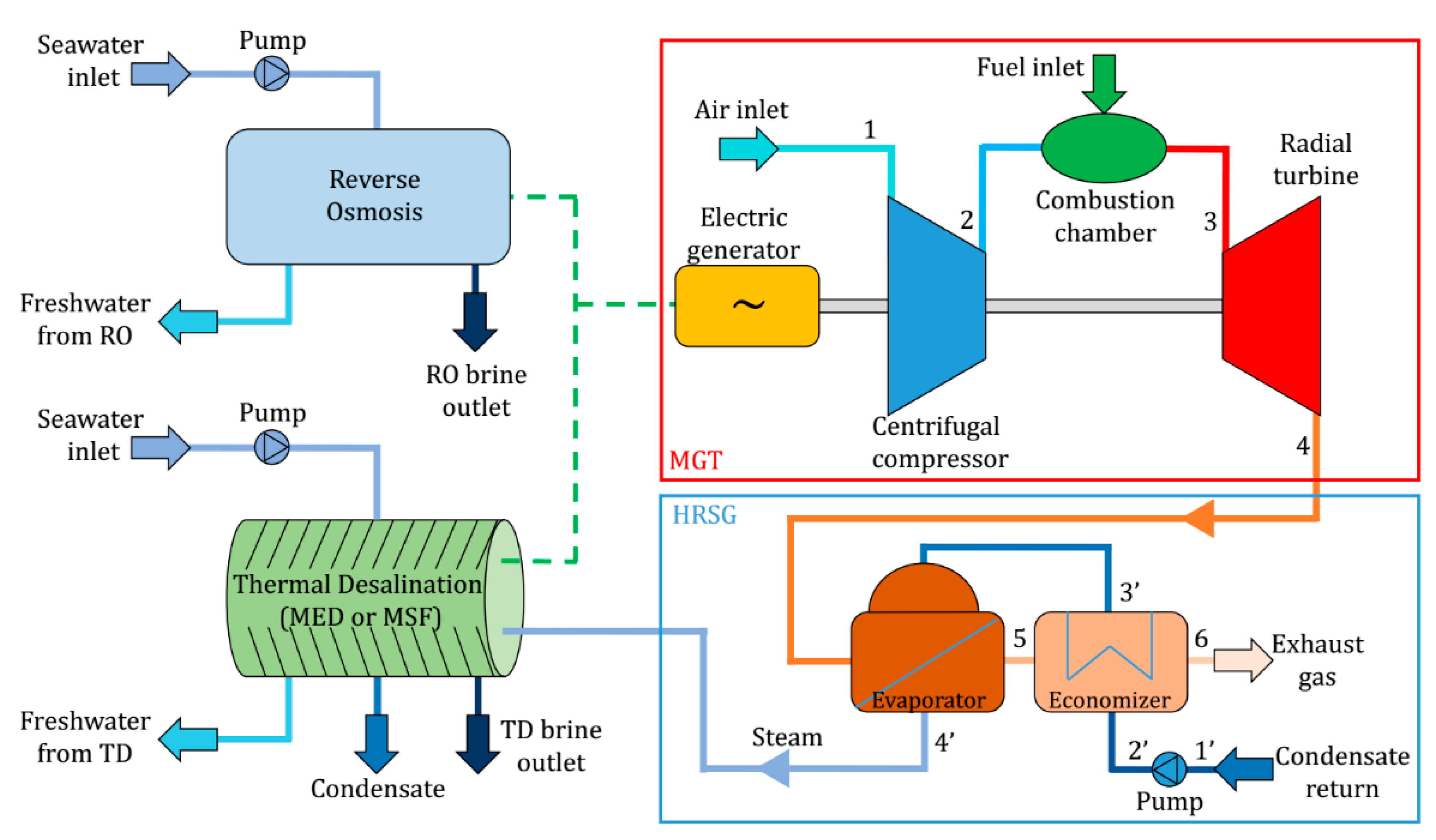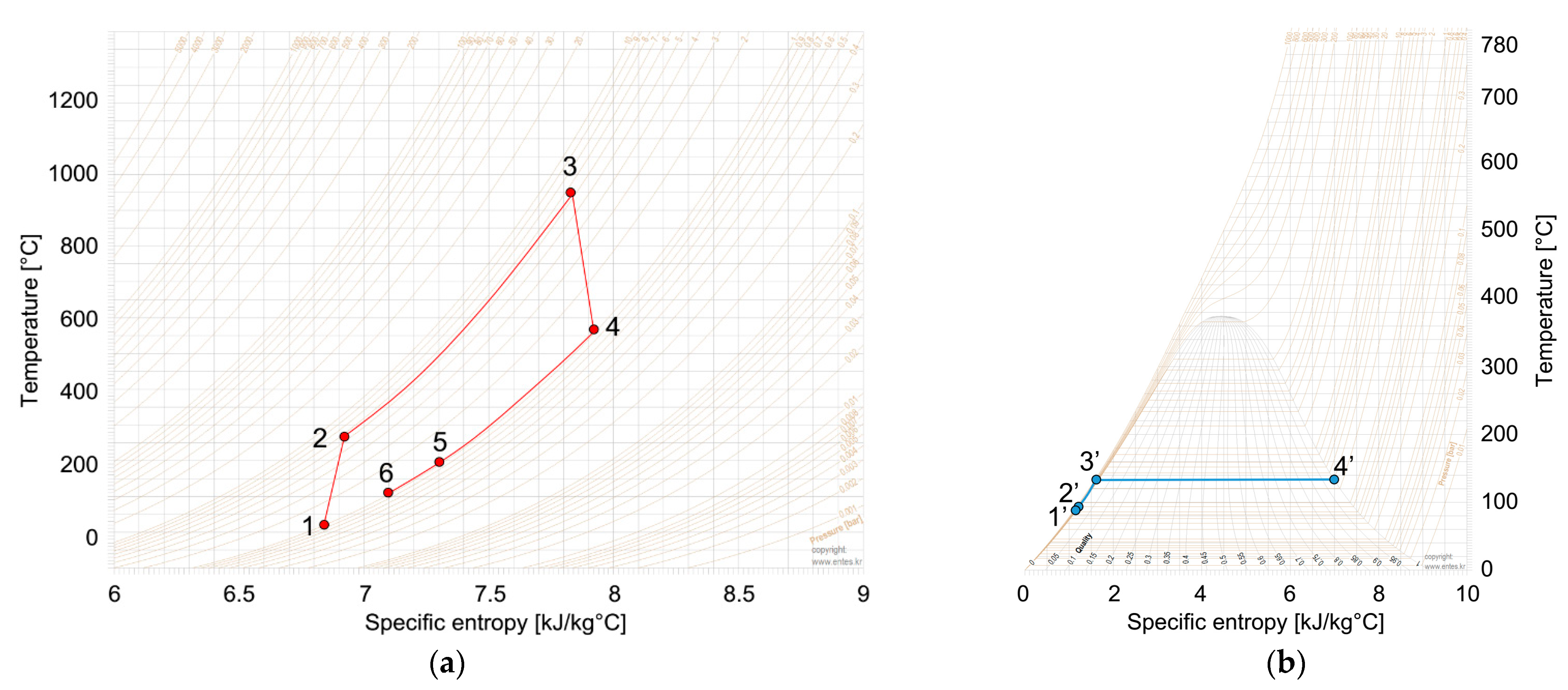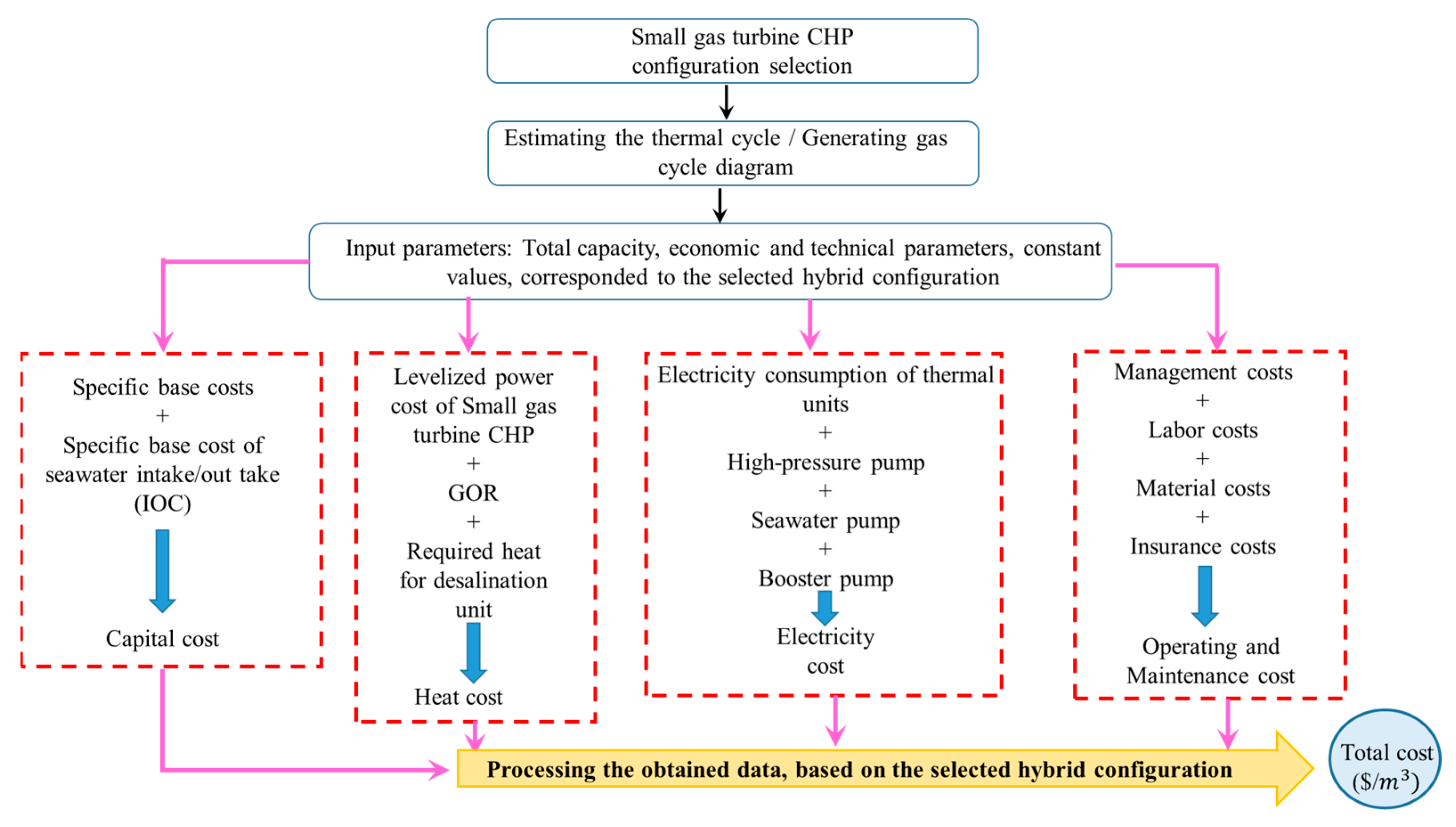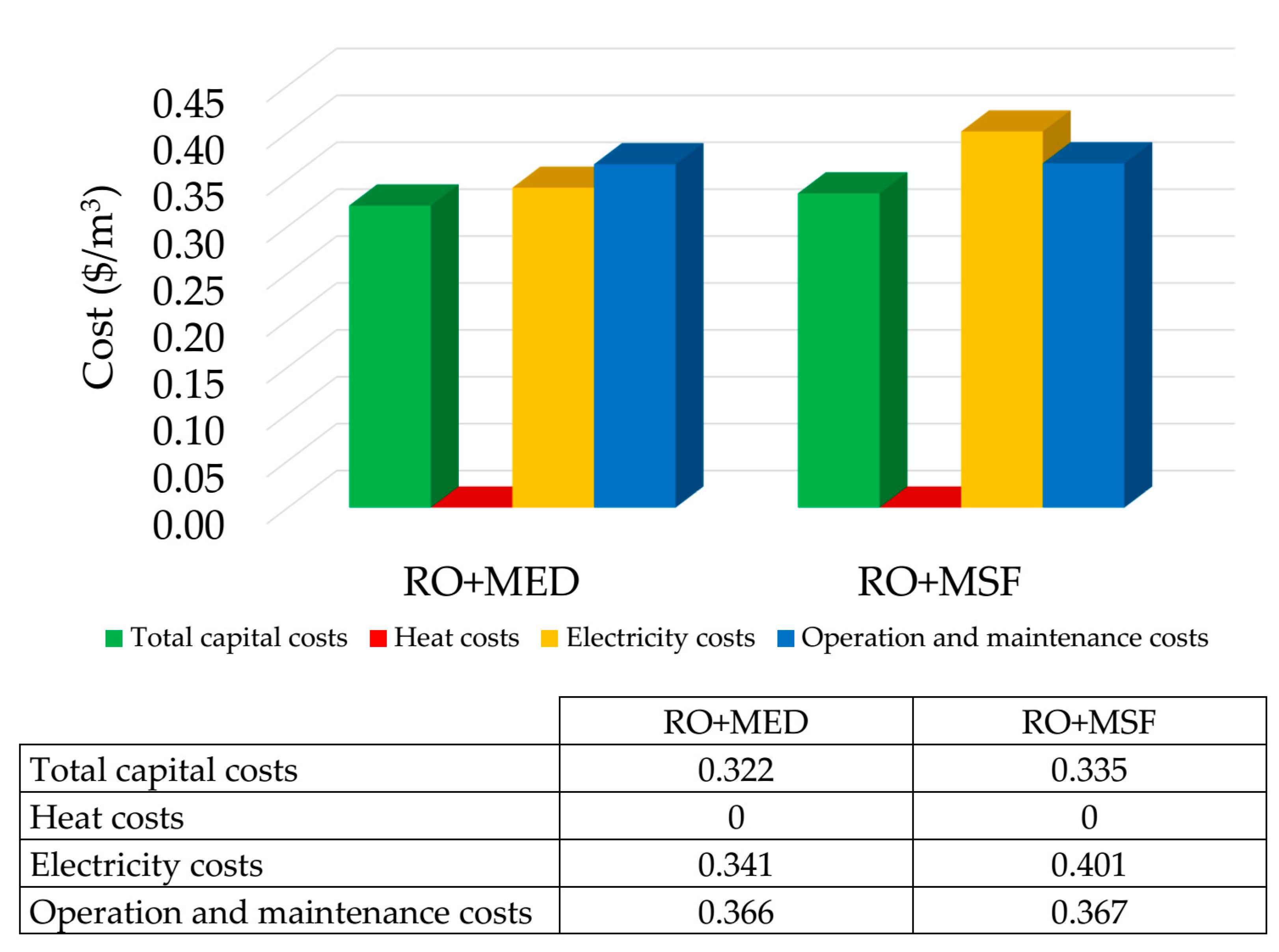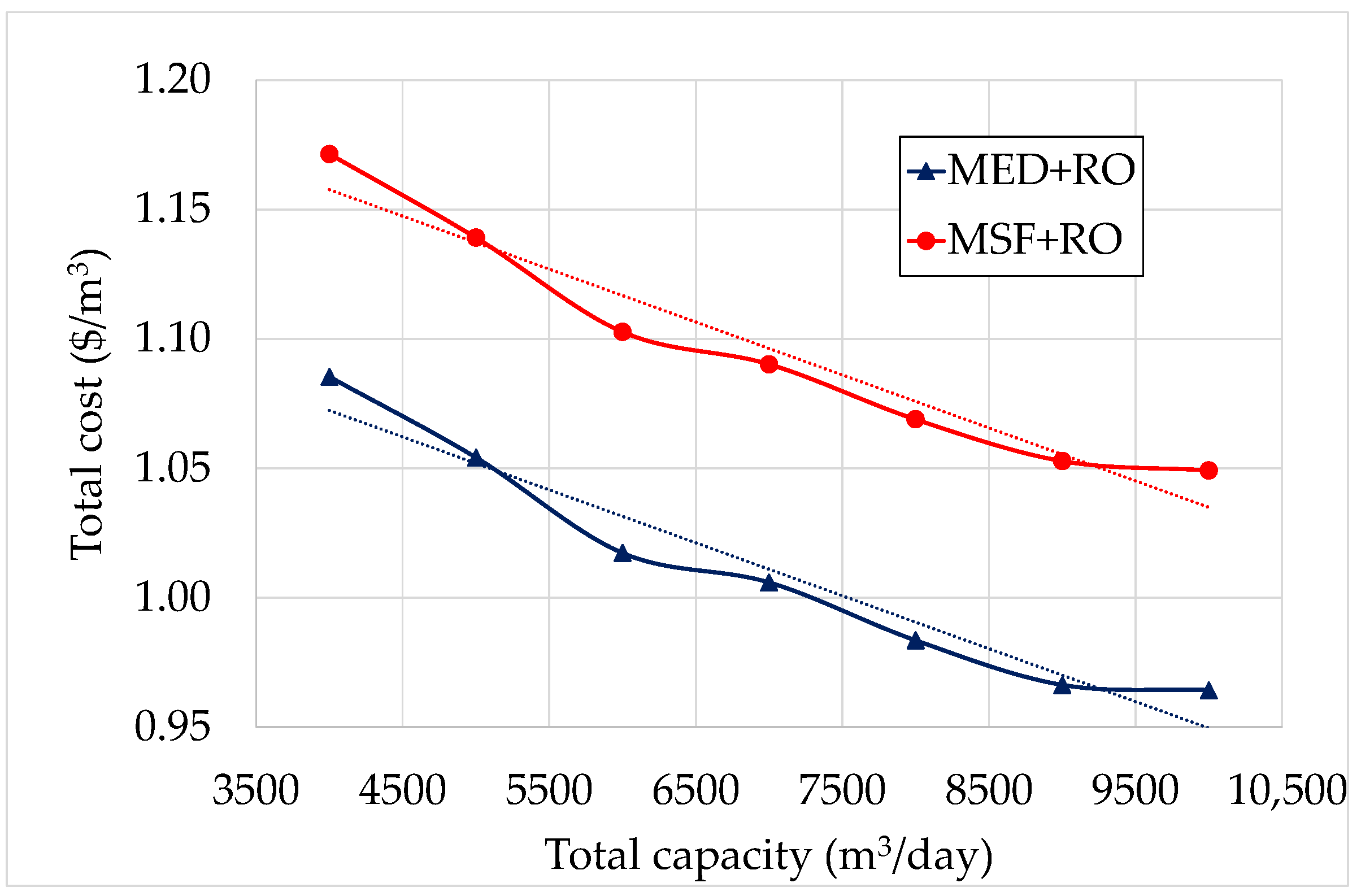1. Introduction
The freshwater shortage problems have been increasing in different regions of the world during the past decades. The freshwater resources are irregularly distributed, hence, a number of regions of the Earth are experiencing or expecting to experience an acute shortage of water resources. Pieces of evidence are more sensible in arid regions, where freshwater supplies are limited, and on the other hand, the brackish and saline water resources are very large and applicable. Therefore, the development of different systems and methods for freshwater production from those sources could be of great value, taking advantage of different seawater desalination technologies [
1].
Regarding the fact that commercial desalination technologies require large amounts of energy, researchers aimed to investigate possible alternatives to raise the overall efficiency of these systems [
2]. A huge number of Desalination Plants (DPs), nearly 20,000 in the Middle East, North Africa, East Asia and Pacific, Western Europe, North America, and some other regions, are already operating, with about 95 million m
3/day of production capacity [
3].
According to the reports of the International Desalination Association, DPs supply the water demands of more than 300 million people all around the world.
Desalination processes are categorized into two main groups of thermal and membrane processes. Thermal processes are mainly based on the use of thermal energy, which allows vaporization and therefore, the distillation of water to obtain freshwater, while membrane processes require the supply of work, usually through electric energy, capable of overcoming the osmotic pressure and forcing the passage of water through membranes that allow it to be filtered.
Multi-stage flash (MSF) and multi-effect distillation (MED) can be regarded as the most popular thermal technologies [
4]. MSF was the dominant distillation process during the 1980s to the 1990s because of its acceptable technical and operational quality as well as its availability throughout its lifetime [
5]. MSF uses both thermal and electrical energy, even if the amount of electrical energy required is small in comparison to the thermal one. Both MSF and MED technologies can purify very salty water, i.e., with the amount of Total Dissolved Solids (TDS) of up to 70,000 mg/L to obtain a final value of TDS of about 5–25 mg/L. The structural simplicity and high capacity can be stated as the most important advantages of MSF technology. For the case of MED, the temperature of the first (warmest) effect usually reaches nothing above 70 °C to avoid the possibility of scale formation [
6]. As an advantage of MED, the low temperature of the operation can be stated, which provides the possibility of using economical and durable materials such as aluminum alloys for the heat exchanging tubes instead of copper alloy tubes. In the case of MED, a very low temperature drop between effects (1.5−2.5 °C) can be achieved, which enables the inclusion of a large number of effects, i.e., 10−16, with the maximum brine temperature of about 70 °C.
For energy saving, it is highly convenient to take advantage of the cogeneration concept, which is highly recommendable, since it can be carried out by use of waste heat from a standalone power plant, leading to the lowest desalination costs. Several examples of case studies have been proposed and analyzed in the past, such as [
7] and [
8]. The turbine exhaust gas was supplied to the heat exchanger, by which the feedwater temperature rose to about 70–90 °C. The obtained heated water passed through the evaporation chamber, in which the evaporation process took place.
Among the membrane desalination systems, the Reverse Osmosis (RO) membranes have become the predominant solid removal mechanism. The commercial RO processes lead with 53% of the total desalination market, while the thermal desalination technologies constitute about 33% of the market, and the rest consists of Electrodialysis (ED) technology and other processes [
2]. Although membrane processes have undergone, and are still undergoing, improvements related to production technology and control and maintenance techniques [
9], the RO membranes still have some serious disadvantages such as membrane fouling, which took place by the accumulation of particles on the surface of the membranes or inside the narrow pores [
10]. Moreover, the freshwater quality obtained from thermal processes (based on distillation) was higher with respect to membrane methods (based on filtration) one. The amount of energy consumption was different for each of the desalination methods. The thermal and electrical energy required for obtaining one cubic meter of freshwater is 53–70 kW
thh and 2.5–5.0 kW
eh by means of the MSF method, and 40–65 kW
thh and 2.0–2.5 kW
eh by means of MED, respectively [
6]. The RO membranes used about 4.0–6.0 kW
eh to produce the same amount of freshwater, depending on the salinity and temperature of the feedwater [
6].
By making use of hybrid desalination processes, an increase in the efficiency of the DPs can be expected. Generally, the procedure is based on the utilization of at least two different desalination technologies, by which the excellence of both methods are applicable. In principle, this method is being used as an alternative way to enhance the produced water quality by RO membranes through the utilization of thermal desalination processes. The advantages of the hybrid technologies in a DP can be listed as follows [
6,
11]:
Reduction in the amount of seawater intake by utilizing the brine of one process as the feedwater of another desalination system;
Improvement of the overall produced water quality, with respect to standalone RO method, by mixing the obtained water from the RO and thermal desalination block;
Reduction in the cost of obtained pure water from the standalone thermal DP;
Prolonging the lifetime of the membranes;
Increase in system efficiency by means of preheating the RO membrane in integrated systems;
Reduction of the overall energy consumption by means of employing the considerably hotter water from the MSF discharge line as the heat source of MED block;
Reduction of total post-treatment costs by mixing the obtained water from thermal and membrane desalination units;
The possibility of using water with different qualities (different amounts of TDS) for various purposes in the power plant site or for drinking and other uses.
In coupling the desalination systems and power plant, a key point is the overall performance of the complex, both from energy and economic points of view [
12,
13,
14]. A possible solution, nowadays widely investigated due to the advantages in terms of environmental impact (e.g., [
15,
16,
17,
18]), could be the use of renewable energy as the power source for the desalination process. However, the reduced energy intensity, as compared with conventional energy sources, and the intrinsic intermittence in this kind of energy source represents important drawbacks.
Considering the above mentioned, the gas cycle integration to the desalination units is preferred, in a way to use the waste heat of the exhaust in order to provide the required energy for thermal desalination technologies. Reliability, high efficiency, considerably lower cost, and pollutant emissions (in comparison to the other fossil fuel-based plants) can be considered as the primary advantages of such combinations. In addition, the overall efficiency of recommended cogeneration plants may be improved through implementing suitable power plant and desalination unit combinations. Following this, improvement can be obtained by utilization of the low potential steam in the MED desalination unit, before directing it into the condenser [
19].
From an economic point of view, it is highly advisable to supply the required heat by taking the advantage of the high potential exhaust gas, the temperature of which is high enough to drive MED or MSF systems. With that being said, the thermal energy cost will be considerably decreased due to the fact that there will not be required any additional heat, which means practically zero power loss by means of the integration.
For all the stated reasons, the obtained freshwater costs from thermal desalination units will be competitive with those produced by RO technology. In this paper, while the authors refer to their earlier works [
4,
6,
20,
21,
22,
23,
24,
25], the focus is different, since the design process is applied to small CHP power plants intended for off-grid applications. In the next section, the proposed system is presented and deeply described, while in the following part of this paper, some economic analysis is presented in order to evaluate the cost of produced water.
2. Power Generation Plant and Associated Thermal Cycle
As previously stated, hybrid desalination systems, and, in particular, those that use RO and thermal distillation processes, require both thermal energy and electricity. For this reason, the choice of the energy production system turns out to be an important step since it defines, through the characteristics of the plant itself, the characteristic ratio between electricity and heat produced.
Large-scale gas turbine power plants are based on axial machine architecture, which allow high gas mass flow rates that, associated with high-pressure ratios (in the order of about 20), allow the production of a huge amount of power. Furthermore, the high value of the gas temperature at the turbine outlet allows heat recovery by means of combined gas–steam cycles, where a bottoming steam turbine increases the overall electrical efficiency. However, in the case of small plants, of the order of few MW, the choice of plant architecture can conveniently fall on radial turbomachines. Indeed, the radial architecture, which is more suitable for lower mass flow rates (and therefore, powers) and overall moderate cycle pressure ratios (of the order of 4–7), allows the machines to be built in a single stage, with consequent cost reduction. In addition, the geometry constraints of the radial turbine configuration prevents the use of cooling technologies, further simplifying the mechanical construction of the machine against a lower overall efficiency of the cycle.
For the present case, where a power of about 5 MW
e was chosen, the radial configuration of the Mini Gas Turbine (MGT) machines is still feasible, and that allows compact machines with moderate technological complexity. The high value of the exhaust gas temperature at turbine outlet, however, promotes the adoption of heat recovery systems, such as Heat Recovery Steam Generators (HRSG), which can be used for the production of steam with characteristics suitable for a steam turbine, featuring a combined cycle power plant [
25] or direct use in desalination systems.
Following these considerations, the plant here proposed used a simple gas topping cycle (Brayton–Joule cycle), i.e., without regeneration. The maximum turbine inlet temperature was fixed by the material since cooling techniques cannot be applied due to the machine geometry. This value was set at 950 °C, which is a limit value for Nickel superalloys to ensure the mechanical durability of the turbine. In order to maximize the cycle electrical efficiency, a characteristic cycle pressure ratio of 6, obtained from a systematic analysis of the cycle characteristics by means of an in-house developed code for cycle analysis, was adopted.
The turbine exhaust gases have a high temperature value. The gas enthalpy can therefore be conveniently used for the generation of steam with characteristics suitable for the application to be implemented. For the choice of these values, it is necessary to consider the requirement on supply temperature of the system. Considering the two types of thermal processes here evaluated, the most stringent temperature condition was imposed by the MSF system, which required temperatures of the order of 90–120 °C. Considering thermal losses in the section between HRSG and desalination plant, for a hybrid desalination system, it was chosen to generate steam at a pressure of 3 bar and temperature of 133.5 °C. On the other hand, the required pressure for both thermal desalination plants was less than 1 bar, but the pressure losses in the circuits have to be taken into account. In any case, starting from higher values, it was possible to regulate the desired temperature and pressure. The schematic representation of the plant is shown in
Figure 1.
The air in ambient conditions (1) is sucked by the centrifugal compressor, which increases the pressure and consequently, the temperature (2), and then is used to burn the fuel (in this case, methane) within the combustion chamber. At the outlet of the combustor (3), the exhausts at high temperature (950 °C) enters the radial turbine, where they expand (4), generating the work used to move the centrifugal compressor and to drive the rotor of the electric generator. The exhaust gas downstream of the turbine passes through a HRSG to vaporize the water provided by a pump (from 1’ to 2’), obtaining the dry saturated steam at the exit of the heat exchanger. Since an unfired HRSG is considered, the path of the exhausts proceeds in the opposite direction to that of the water, which, once passed by the economizer (3’), enters the evaporator to give rise to the desired steam conditions (4’). The assumptions made for cycle performance evaluation are listed in
Table 1.
The temperature difference between gas and steam in the economizer (Δ
T pinch point) had been chosen equal to 10 °C, and a subcooling temperature of 5 °C had been foreseen to avoid risks of evaporation within the economizer. The water temperature at the economizer inlet had been considered equal to 90 °C. The values of gas turbine exit temperature and mass flow rate (546 °C and 23.96 kg/s, respectively) were obtained again from the in-house developed code for cycle analysis, considering the cycle parameters (pressure ratio, components efficiencies) and the cycle thermal balances. The component efficiency values were determined from statistical analyses of data presented in the literature for machines of similar size to that of the present application and from previous works by the authors [
26,
27].
Using the assumptions reported in
Table 1, and applying the energy equations to the two HRSG components (economizer and evaporator), the gas temperature at the exit of the HRSG, the mass flow rate of the produced steam, and consequently, the thermal power available, can be obtained. With these assumptions, the gas cycle and the steam generation process diagrams have been obtained, as presented in
Figure 2 [
28].
In
Table 2 and
Table 3, values of the thermodynamic quantities characterizing the cycle points and the power plant’s overall parameters are reported.
As shown by
Table 2 and
Table 3, due to the large value of the turbine outlet temperature (546 °C), a large amount of heat power was recovered through the heat recovery steam generator, with a global efficiency of the combined heat and power system much larger than the electrical efficiency of the standalone gas turbine. Indeed, the heat power obtained by the HRSG was almost twice the electrical power generated by the mini gas turbine alone. This result shows a high potential for the hybrid DP here proposed, offering the opportunity of contemporarily providing both thermal and electric power to the two desalination technologies, and consequently, maximizing the freshwater production for unit fuel mass flow rate.
3. Economic Evaluation and Results
The main purpose of this section is the economic analysis of the possible desalination technologies for an integrated mini gas cycle equipped with a hybrid desalination plant. In order to achieve this goal, the coupling of the water desalination to the proposed gas cycle-based plants on the two possible scenarios of hybrid seawater desalination was performed and investigated. Moreover, the economic assessment of standalone desalination systems was also carried out, in order to compare these with the other options. In
Table 4, the basic parameters for economic calculations are listed. The techno-economic evaluation flowchart based on the DEEP (Desalination Economic Evaluation Program) program is shown in
Figure 3. DEEP was originally developed by General Atomics under contract, and has been used in the IAEA’s feasibility studies. DEEP output included the levelized cost of water and power, a breakdown of cost components, energy consumption, and net saleable power for each selected option. Specific power plants can be modeled by adjustment of input data including design power, power cycle parameters, and costs [
29].
According to
Figure 3, the total cost of the produced water for each method is composed of several contributions, namely, capital cost, heat cost, electricity cost, and operating and maintenance costs. A new module for obtaining the gas cycle diagram was coupled to this algorithm to provide the additional technical information. After obtaining the initial results, a data process algorithm was developed to extract the desired economic data.
Generally, the energy cost of a desalination plant is obtained by using the Levelized power cost (
$/kWh). The Levelized power cost (Levelized cost of the power system) is obtained by comparing the total annual cost of the power plant with its total annual electric producibility. The total annual cost of the plant is the summation of several components such as annual fuel cost, annual operation and maintenance (O & M) cost, and annual capital cost. Hence, the fuel cost indirectly affected the total cost of the produced freshwater [
24].
The economic evaluation for the required energy of the hybrid desalination plant was done based on the Levelized power cost, in which the fuel cost is a very important component.
The cost of the required heat for the thermal desalination plant, in this work, was zero, because the required energy was supplied by the waste heat of the gas turbine plant.
According to the given technical information for the proposed small gas turbine, the available heat for thermal desalination plants was 10,180 kW
th. The relation between total capacity of thermal desalination plant and required heat can be expressed using Equation (3) [
30].
where
is gain output ratio of thermal desalination plant (in this case, is equal to 13 and 12 for MED and MSF, respectively),
is capacity of thermal plant, and
is the latent heat of vaporization. According to this formula, 10,180 kW
th energy potentially can produce 5035 and 4780 m
3/day of freshwater by MED and MSF technology, respectively. Hence, in
Table 5, the obtained results of economic evaluation for standalone thermal desalination systems corresponding to the two mentioned capacities are listed.
For comparison, the total capacity of the RO plant was also considered as 5000 m
3/day. In the above table, the MSF technology is supposed to be the most expensive technology of water desalination among all of the technologies, because of the higher amount of required heat energy for running the desalination plant. Finally, the obtained results of two different hybrid configurations are shown in
Table 5. The total capacity of the hybrid scheme was 13,000 m
3/day. Furthermore, the degree of hybridization of the hybrid plant was considered at 35%. The degree of hybridization was a key parameter, by which the share of produced water by thermal desalination plant in total produced water of system was defined. Hence, in this example, the capacity of the thermal plant was 4550 m
3/day, and the capacity of the RO plant was 8450 m
3/day. These values were selected in a way in which not only almost all the waste energy can be used, but also a proper comparison between various options can be performed (at the same capacity). As can be seen in
Table 5, the total cost of the produced water by MED + RO was less than the total cost of the produced water by MSF + RO.
According to
Table 5, the total cost of the produced water was formed of three main components, namely energy cost, capital cost, and operating and maintenance cost. The energy cost of the desalination plant was also the summation of electricity cost and heat cost. According to this table, both hybrid (MED + RO) and RO methods used electricity (RO plant used electricity for driving the high pressure pump and MED used electricity for driving the pumps, and other electrical equipment). On the other hand, RO plant did not need thermal energy, therefore, the heat cost of RO was zero (it should be noted that the electricity consumption of the RO plant was more than the MED plant). The MED plant needs heat energy, however, this energy was supplied by the waste heat of the gas turbine and consequently, the heat cost of the MED was zero. According to
Table 5, the energy cost of RO was 0.401
$/m
3, while the energy cost of RO + MED was 0.340
$/m
3, making it clear that by using hybrid technology, the energy cost decreased.
The capital costs corresponded to the cost of the plant itself and the costs of its construction, depending on the construction time. Basically, the main components of capital costs were base cost, ownership cost, contingency costs, and interest during construction. The total base costs (TBS) were defined as sum of the specific base costs (SBC), the specific cost of the intermediate heat exchanger (if it is necessary) between the HRSG and the thermal DP (SIHXC), the base cost of the reserve heat source for MSF and MED (RHSC), and the specific base cost of seawater inlet/outlet (IOC). It is worthwhile to mention that the unit base cost was an average value, which depended on the desalination plant construction experience in a particular region. As an example, the average value for MED, MSF, and RO installations in Southwest Asia was approximately 1300, 1400, and 900 (
$/m
3/day), respectively. The total basic costs of desalination plant can be obtained by [
23]:
The ownership cost (OWC) can be evaluated as a fraction of the total basic costs (ownership factor) of desalination plant. This fraction mostly depends on the economic conditions of the selected region and usually may vary between 5% and 10% [
23].
Contingency cost (CGC), which refers to costs that will probably occur, based on past experience, can be estimated as a fraction of total base cost and ownership cost. In this study, the contingency factor is assumed to be equal to 8%.
However, one of the main components of capital cost is interest during construction (IDC), and this parameter can be determined using the following formula [
23]:
where, IR is the interest rate, which depends on the economic condition of the selected region, LT (hours) is the construction time of desalination plant, which mainly depends on the technological feasibility and previous experiences in designing the desalination plant. According to
Table 5, it is worth noting that, although the energy cost of hybrid method was lower than that of the RO method, the total cost of the hybrid system was more than that of RO method. The main reason for this situation was related to capital cost and capacity of the plant. The capital cost of the desalination plant corresponded to the unit base cost [
$/m
3/day], and according to many references, the unit base cost for thermal desalination plants was larger than for RO plants (for example, 1200 [
$/m
3/day] for MED and 900 [
$/m
3/day] for RO, for a typical country in the Middle East). By increasing the capacity of the plant, the effect of this parameter decreased. In this study, the capacity of thermal plant was small (for MED, about 5000 m
3/day). Hence, the capital cost of the thermal plant was larger than that of the RO plant and, consequently, the total cost of the hybrid system was larger. Certainly, by increasing the capacity of the plant (for example, a large-scale desalination plant with capacity of 100,000 m
3/day), the total cost of the hybrid plant will decrease in comparison to a stand-alone RO desalination plant [
23,
24].
The graphical representation of the results obtained for the hybrid systems is given in
Figure 4.
It should be noted that the waste heat of exhaust gas provided the required energy for the thermal desalination plant. Consequently, as can be seen in
Figure 4, the heat costs of both hybrid desalination technologies are supposed to be zero. In order to facilitate the evaluation, except for the particular properties of the gas cycles, all other technical and economic input parameters were assumed the same as the default of the DEEP software database. In
Figure 5, the total costs of the produced water for two different hybrid desalination options in various total capacities are presented. The degree of hybridization for this case was 35%, and the range of the variety of total capacity was from 4000 to 10,000 m
3/day. According to this figure, by increasing the total capacity, the total cost of the produced water decreased.
4. Conclusions
Nowadays, the water shortage is a world critical problem. Considering the fact that seawater desalination is one of the most appropriate ways to solve this water deficit problem, many pieces of research have aimed to investigate efficient procedures in the desalination industry. However, since all commercially available desalination processes require a large amount of energy, the use of a proper energy source for desalination purposes plays a significant role in decreasing the final costs of water and equipment. In the present paper, the adoption of small power plants based on gas turbine engine as the energy source was proposed. The power system proposed (5 MWe for the gas turbine unit), has been coupled with a hybrid desalination plant, based on the use of two different desalination technologies, i.e., RO and a thermal desalination process. In particular, two different types of hybrid desalination schemes integrated with small gas turbine CHP systems were analyzed. The selected size of the power plant was defined according to the upper limit of the simplified GT architecture, adopting single-stage radial machines for compressor and turbine. The obtained data were broadly consistent with the major trends of economic evaluations, which have been conducted in other researches. From the research that was undertaken, one may conclude that hybrid desalination can be considered as a suitable technique to optimize the total water cost, especially in those regions where not only the water demand is increasing year by year, but also where the status of economic conditions is under the normal situation.
In particular, according to the obtained results, it was found that:
- -
the total cost of the produced water by MSF + RO technology was almost 6.7% larger than MED + RO technology.
- -
the water costs of both MED + RO and MSF + RO desalination plants decreased by increasing the total capacity, from 1.17 to 1.05 $/m3 and 1.085 to 0.96 $/m3, respectively.
- -
the heat cost of all the thermal desalination systems vanished since the waste heat of the gas turbine cycle was used as the heat source.
- -
the total energy cost of MED + RO desalination was 0.341 $/m3, which was 15% less than the energy cost of the stand-alone RO system.
- -
the total capital cost of the MED + RO was 0.322 $/m3, which was 13% more than the capital cost of the RO system for the low capacity desalination systems taken into consideration in the present study.
The most striking result which emerged from the obtained data was that the RO + MED scheme of hybrid desalination was much more affordable in comparison to other suggested schemes. The water cost obtained by the suggested scheme in this study obviously was less than the water cost obtained by the renewable-based power plant. According to Esmaeilion [
31], the water production cost of a 5000 m
3/day solar-thermal desalination system was around 2
$/m
3, which is almost double than the cost of MED + RO suggested in this work. This difference in cost is remarkable, however, environmental benefits of renewable energy or hybrid energy systems should be taken into consideration. The water cost difference between the presented solutions in this paper and those systems adopting renewable energies may become smaller in cases of relevant fuel cost increase.
